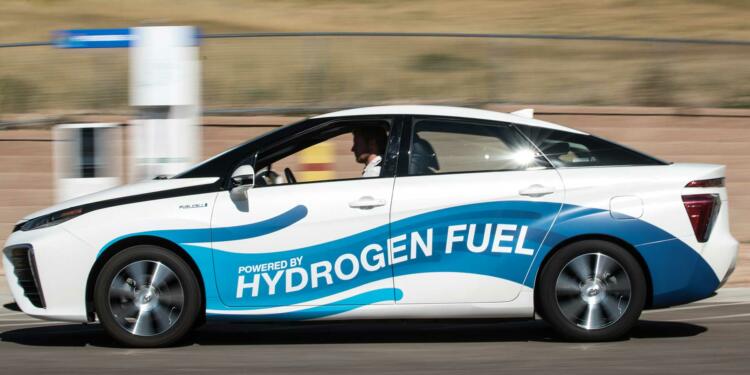The world is changing. Crude oil is becoming expensive and environmentally unsustainable. The entire world agrees about one thing- if the human race doesn’t cut down on the consumption of fossil fuels, the stock of fossil fuels would get exhausted and global warming will turn into an irreversible disaster.
The world is looking for solutions and one immediate solution is decarbonising the way we travel. Presently, our cars and public transport consume way too much oil or natural gas and they also release toxins into the environment doing further damage to the climate change campaign. So, the world is looking at electric vehicles (EVs) as its solution. However, there is a far better solution- hydrogen-powered fuel cell vehicles (FCVs).
Hydrogen cars and electric cars
For the unversed, FCVs and EVs are completely different.
- EVs work on electric motors that rely on flow of current from a rechargeable battery.
- FCVs have a hydrogen tank just like your car has a petrol/ diesel tank. It mixes pressured hydrogen with oxygen and an electrochemical reaction is produced to move the vehicle.
So, an FCV is essentially a hybrid vehicle as they have trappings of both an electric vehicle and a conventional vehicle due to use of electric energy and a fuel tank at the same time.
Why Hydrogen cars are better
Yet, FCVs seem a better option because of:
- The abundance of hydrogen in nature.
- No use of fossil fuels in procuring hydrogen fuel.
- Ability to travel longer distances as hydrogen cars pack their energy storage densely.
Lithium issues
Apart from the concerns surrounding global warming, one big reason why the world wants to scrap conventional vehicles is the monopoly of a few countries over energy resources. We no longer want a world where a few oil-producing countries form a cartel and dictate the global automobiles market.
However, EVs don’t really solve this problem. Lithium, the most important metal required for Li-ion batteries used in Electric Vehicles, is a finite resource and its demand is set to skyrocket as EVs begin to replace fossil fuel-run vehicles. While only about 3 grams of the light element is used in smartphones, electric vehicle batteries use 10 kilograms of Lithium.
In fact, Lithium-ion batteries will demand the mining of tons of Lithium, and not all nations have the necessary reserves of the metal. This is why Lithium is being described as white gold. China, for example, has already started importing huge quantities of Lithium as it wants to preserve its own stocks of the metal for the future.
Charging troubles
Ask any millennial- the biggest headache of the 21st-century world is charging electronic devices- mobile phones, Bluetooth speakers, hair trimmers, driers and so on. Do we want to add another device to this list? Certainly not.
Consider this, a hydrogen fuel tank can be filled in 5 to 10 minutes. On the other hand, even Tesla’s fast chargers with 120 kW give 80% battery in thirty minutes. Also, not everyone can own a Tesla and other electric automobiles might take even more time to charge.
Since we are on the subject of charging, we ought to understand that charging the EVs won’t be an easy task either. A huge infrastructure in the form of charging stations will have to be built in the country in order to make traveling by EV practicable in the first place. FCVs, on the other hand, can rely upon the already existing pump stations network if and when the country is ready to transform its vehicles market.
Why EVs aren’t as clean as touted to be
Operating hydrogen cars will involve burning hydrogen, which will be truly a zero-emission activity. On the other hand, running EVs won’t be so simple. The EVs are in themselves zero-emission vehicles, but what about the electricity needed to power them.
Developing countries like India and China still rely predominantly on coal-powered thermal energy, which isn’t really a clean source of electric energy. Transformation to wind energy and solar energy will still take some time. So, if you use coal-powered thermal plants to run EVs, it does not really save the environment and we only shift from one type of hydrocarbons to another type of hydrocarbons while driving our automobiles.
Hydrogen fuel cell vehicles, on the other hand, offer a more equitable and environment-friendly mode of travel. Hydrogen cars are therefore the real future and not electric cars. True, hydrogen cars are still in the nascent stage of development whereas EVs are knocking at our doors. But once fully developed, hydrogen cars will get accepted as the better alternative.



































Great article Akshay but I think you missed a really important thing.
Lithium is only 2% of a battery.
The real mining problem is the other metals.
The ore for them is at best 2% pure.
So for 1000lbs of battery metal 50,000lbs of ore needs to be mined and processed.
1000lb battery = 20lbs lithium and 49,000lbs of metal ore.
Gosh, I personally wish this was true (because I am deeply biased against the most well-known EV brand and in favour of Japan, that’s personal). But we all know it isn’t. Isn’t most hydrogen made from fossil fuels? And doesn’t making “green” hydrogen require unefficently much energy? It probably will find its use, but more likely in aircraft and big trucks rather than cars.
Hydrogen comes from water. The biproduct or exhaust is distilled water
Electrolysis of water, a.k.a. green hydrogen, is not done now (too expensive). Grey hydrogen using fossil fuel is current technology. Blue hydrogen (also using fossil fuel) is in development. My report shows that blue hydrogen production releases more energy than charging a Tesla. https://docs.google.com/document/d/1fGwzPW22wnVM_iYeWqrbzCLW1ZiCbJRQknjnQEfaYmM/edit?usp=sharing